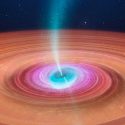Do you love Jupiter? Do you love it so much that you could look at it every day? I hope so. Because it just took the Moon’s place, and Earth will never be the same again.
Why would Earth no longer be a planet? Why would only half of our world get this spectacular view? Could you survive on this new Earth?
No one is quite sure how Jupiter replaced the Moon overnight. All anyone knows is that it’s a beautiful and terrifying sight. This gas giant is 11 times larger than Earth, so depending on where you were, it could take up a huge portion of the sky.
But it’s not just our sky that would change. Jupiter would transform the Earth in several ways.
The Moon doesn’t orbit the exact center of the Earth. Instead, it orbits a point 4,671 km (2,902 mi) off center inside the Earth. It’s called the barycenter. If you were able to combine the Earth’s mass with the Moon’s, the barycenter would be the center point.
With Jupiter in our skies, the barycenter would shift. And I mean, it would really shift. Jupter is 317 times heavier than Earth. So the barycenter would move from inside the Earth to inside Jupiter, drastically changing Earth’s orbit.
Earth wouldn’t be a planet anymore. Instead, we would be Jupiter’s moon.
Okay, so we would live on a moon. No big deal, right? Well, no. It would be a huge deal.
Now that the Earth orbits Jupiter, it would be tidally locked. Jupiter’s strong gravitational pull would cause one side of Earth to always face toward Jupiter. And Earth’s other side would always face toward space. The Earth would still complete one full rotation on its axis in one day. It would also take the same time to complete one orbit around Jupiter.
You’d still have 24 hours days. But a year would be twice as long. In its usual orbit, Jupiter takes 142 Earth months to travel around the Sun. In its new position, Jupiter would take 27 months.
If you were to live on the side of Earth that didn’t face Jupiter, your days would seem normal as the Earth passes in between Jupiter and the Sun. But your nights would be dark and moonless. At least you’d have the stars to enjoy. If you were to live on the side of Earth facing Jupiter, your days would have less sunlight. Depending on Jupiter’s position in the sky, it could partially or fully block out the Sun. And every day, you’d get to feast your eyes on a solar eclipse.
And Jupiter would bathe your nights in yellow light since it would reflect 50% of the sunlight that hits it. And that’s really bright when you compare it to the Moon. The Moon only reflects 12% of the sunlight hitting it, and it’s a lot smaller than Jupiter. So if you turn up the brightness and make it larger, that’s one giant night light.
It doesn’t sound too bad yet. But that’s because I’ve saved the nastiest consequences for last. Remember I said that Earth would be tidally locked? Because of that, Earth could experience tidal heating too. There would be a much stronger gravitational force on the part of Earth facing Jupiter than on the side facing space. And that would start distorting the Earth’s shape.
Deadly earthquakes would become common as parts of Earth were ripped apart. And violent volcanic eruptions would destroy cities and pollute our air. We’re just lucky that Jupiter didn’t bring its other moons into our neighborhood. One of Jupiter’s moons, Io, is undergoing the same type of deformation, making it the most volcanically active world in the Solar System. And it’s not just Jupiter’s fault.
The other moons orbiting Jupiter force Io into an elliptical orbit, making the disastrous effects of tidal heating even more catastrophic. Fortunately for us, the Earth’s orbit would continue to be more like a circle. But Earth’s geographical transformations would still be enormous, and you’d see massive migrations as people moved to safer places.
And it’s not just the volcanoes and earthquakes that could kill you. Radiation from Jupiter would blast our planet, killing or mutating all lifeforms. Oh, and one more thing. Jupiter’s gravitaional force attracts asteroids. And we would be right in their way. It’s looking like you’d have to move underground to survive. So as pretty as Jupiter is, I’d rather it stay where it is, 628 million km (390 million mi) away from Earth.
Sources
- “How Far Away Is The Moon? | NASA Space Place – NASA Science For Kids”. 2021. spaceplace.nasa.gov.
- “Jupiter Fact Sheet”. 2021. nssdc.gsfc.nasa.gov.
- “The formation of Jupiter’s diluted core by a giant impact” nature.com
- “Jupiter’s Great Red Spot“. 2021. NASA.
- “What If The Moon Were Bigger?”. Koerth, Maggie. Fivethirtyeight.
- “Moons Of Jupiter | Exploring The Planets | National Air And Space Museum”. 2021. airandspace.si.edu.


























